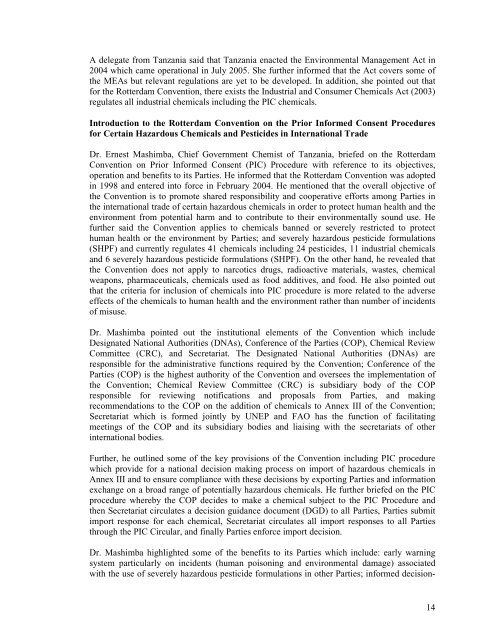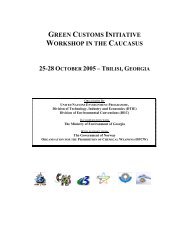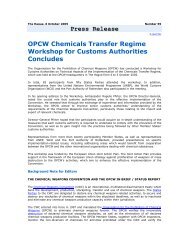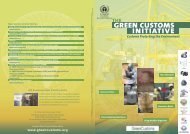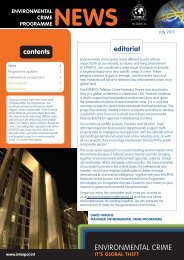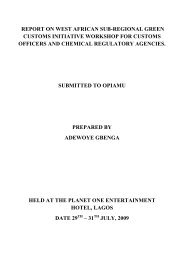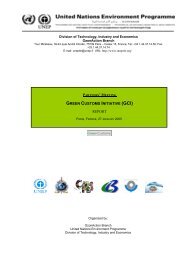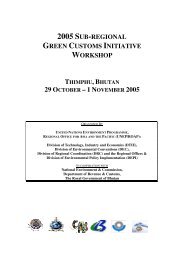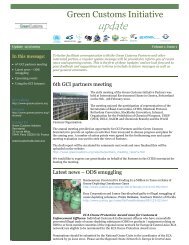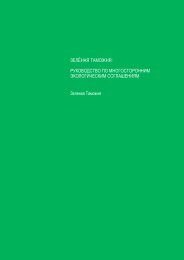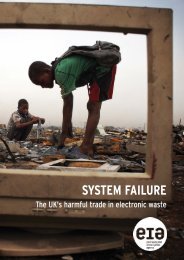Arusha - Green Customs Initiative
Arusha - Green Customs Initiative
Arusha - Green Customs Initiative
You also want an ePaper? Increase the reach of your titles
YUMPU automatically turns print PDFs into web optimized ePapers that Google loves.
A delegate from Tanzania said that Tanzania enacted the Environmental Management Act in<br />
2004 which came operational in July 2005. She further informed that the Act covers some of<br />
the MEAs but relevant regulations are yet to be developed. In addition, she pointed out that<br />
for the Rotterdam Convention, there exists the Industrial and Consumer Chemicals Act (2003)<br />
regulates all industrial chemicals including the PIC chemicals.<br />
Introduction to the Rotterdam Convention on the Prior Informed Consent Procedures<br />
for Certain Hazardous Chemicals and Pesticides in International Trade<br />
Dr. Ernest Mashimba, Chief Government Chemist of Tanzania, briefed on the Rotterdam<br />
Convention on Prior Informed Consent (PIC) Procedure with reference to its objectives,<br />
operation and benefits to its Parties. He informed that the Rotterdam Convention was adopted<br />
in 1998 and entered into force in February 2004. He mentioned that the overall objective of<br />
the Convention is to promote shared responsibility and cooperative efforts among Parties in<br />
the international trade of certain hazardous chemicals in order to protect human health and the<br />
environment from potential harm and to contribute to their environmentally sound use. He<br />
further said the Convention applies to chemicals banned or severely restricted to protect<br />
human health or the environment by Parties; and severely hazardous pesticide formulations<br />
(SHPF) and currently regulates 41 chemicals including 24 pesticides, 11 industrial chemicals<br />
and 6 severely hazardous pesticide formulations (SHPF). On the other hand, he revealed that<br />
the Convention does not apply to narcotics drugs, radioactive materials, wastes, chemical<br />
weapons, pharmaceuticals, chemicals used as food additives, and food. He also pointed out<br />
that the criteria for inclusion of chemicals into PIC procedure is more related to the adverse<br />
effects of the chemicals to human health and the environment rather than number of incidents<br />
of misuse.<br />
Dr. Mashimba pointed out the institutional elements of the Convention which include<br />
Designated National Authorities (DNAs), Conference of the Parties (COP), Chemical Review<br />
Committee (CRC), and Secretariat. The Designated National Authorities (DNAs) are<br />
responsible for the administrative functions required by the Convention; Conference of the<br />
Parties (COP) is the highest authority of the Convention and oversees the implementation of<br />
the Convention; Chemical Review Committee (CRC) is subsidiary body of the COP<br />
responsible for reviewing notifications and proposals from Parties, and making<br />
recommendations to the COP on the addition of chemicals to Annex III of the Convention;<br />
Secretariat which is formed jointly by UNEP and FAO has the function of facilitating<br />
meetings of the COP and its subsidiary bodies and liaising with the secretariats of other<br />
international bodies.<br />
Further, he outlined some of the key provisions of the Convention including PIC procedure<br />
which provide for a national decision making process on import of hazardous chemicals in<br />
Annex III and to ensure compliance with these decisions by exporting Parties and information<br />
exchange on a broad range of potentially hazardous chemicals. He further briefed on the PIC<br />
procedure whereby the COP decides to make a chemical subject to the PIC Procedure and<br />
then Secretariat circulates a decision guidance document (DGD) to all Parties, Parties submit<br />
import response for each chemical, Secretariat circulates all import responses to all Parties<br />
through the PIC Circular, and finally Parties enforce import decision.<br />
Dr. Mashimba highlighted some of the benefits to its Parties which include: early warning<br />
system particularly on incidents (human poisoning and environmental damage) associated<br />
with the use of severely hazardous pesticide formulations in other Parties; informed decision-<br />
14


